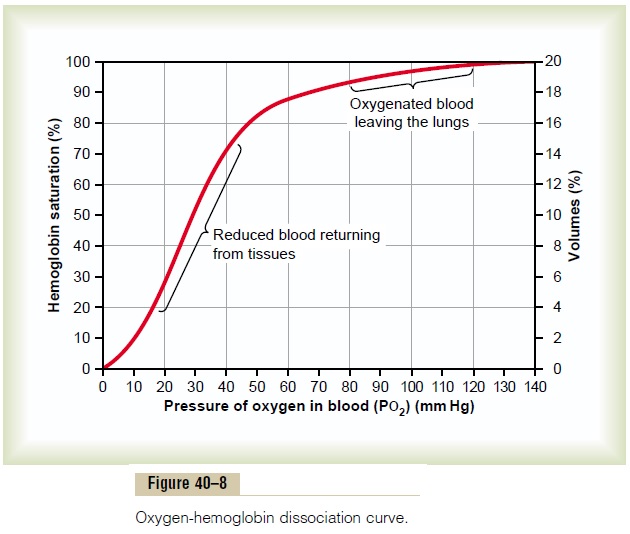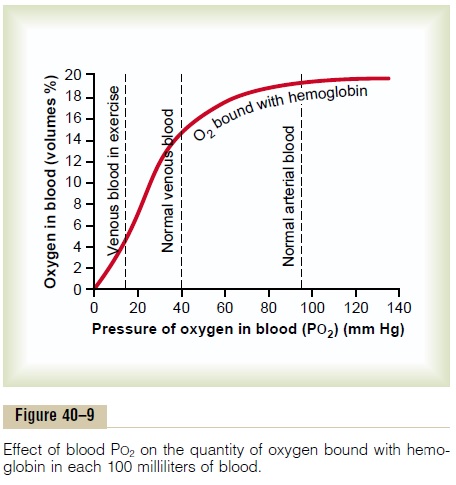Chapter: Medical Physiology: Transport of Oxygen and Carbon Dioxide in Blood and Tissue Fluids
Reversible Combination of Oxygen with Hemoglobin
Reversible Combination of Oxygen with Hemoglobin
The chemistry of hemoglobin is presented, where it was pointed out that the oxygen molecule combines loosely and reversibly with the heme portion of hemoglobin. When PO2 is high, as in the pulmonary capillaries, oxygen binds with the hemoglobin, but when PO2 is low, as in the tissue capillaries, oxygen is released from the hemoglobin. This is the basis for

Oxygen-Hemoglobin Dissociation Curve. Figure 40–8 showsthe oxygen-hemoglobin dissociation curve, which demonstrates a progressive increase in the percentage of hemoglobin bound with oxygen as blood PO2 increases, which is called the per cent saturation ofhemoglobin. Because the blood leaving the lungs andentering the systemic arteries usually has a PO2 of about 95 mm Hg, one can see from the dissociation curve that the usual oxygen saturation of systemic arte-rial blood averages 97 per cent. Conversely, in normalvenous blood returning from the peripheral tissues, the PO2 is about 40 mm Hg, and the saturation of hemo-globin averages 75 per cent.
Maximum Amount of Oxygen That Can Combine with the Hemoglobin of the Blood. The blood of a normal personcontains about 15 grams of hemoglobin in each 100 milliliters of blood, and each gram of hemoglobin can bind with a maximum of 1.34 milliliters of oxygen (1.39 milliliters when the hemoglobin is chemically pure, but impurities such as methemoglobin reduce this). There-fore, 15 times 1.34 equals 20.1, which means that, on average, the 15 grams of hemoglobin in 100 milliliters of blood can combine with a total of almost exactly 20 milliliters of oxygen if the hemoglobin is 100 per cent saturated. This is usually expressed as 20 volumes percent.The oxygen-hemoglobin dissociation curve forthe normal person can also be expressed in terms of volume per cent of oxygen, as shown by the far right scale in Figure 40–8, instead of per cent saturation of hemoglobin.
Amount of Oxygen Released from the Hemoglobin When Sys-temic Arterial Blood Flows Through the Tissues. The totalquantity of oxygen bound with hemoglobinin normal systemic arterial blood, which is 97 per cent saturated, is about 19.4 milliliters per 100 milliliters of blood. This is shown in Figure 40–9. On passing through the tissue capillaries, this amount is reduced, on average, to 14.4 milliliters (PO2 of 40 mm Hg, 75 per cent saturated hemoglobin). Thus, under normal conditions, about 5milliliters of oxygen are transported from the lungs to the tissues by each 100 milliliters of blood flow.
Transport of Oxygen During Strenuous Exercise. Duringheavy exercise, the muscle cells use oxygen at a rapid rate, which, in extreme cases, can cause the muscle interstitial fluid PO2 to fall from the normal 40 mm Hg to as low as 15 mm Hg. At this low pressure, only 4.4 milliliters of oxygen remain bound with the hemoglo-bin in each 100 milliliters of blood, as shown in Figure 40–9. Thus, 19.4 – 4.4, or 15 milliliters, is the quantity of oxygen actually delivered to the tissues by each 100 milliliters of blood flow. Thus, three times as much oxygen as normal is delivered in each volume of blood that passes through the tissues. And keep in mind that the cardiac output can increase to six to seven times normal in well-trained marathon runners. Thus, multi-plying the increase in cardiac output (six- to sevenfold) by the increase in oxygen transport in each volume of blood (threefold) gives a 20-fold increase in oxygen transport to the tissues. We see later that several other factors facilitate delivery of oxygen into muscles during exercise, so that muscle tissue PO2 often falls very little below normal even during very strenuous exercise.

Utilization Coefficient. The percentage of the blood thatgives up its oxygen as it passes through the tissue cap-illaries is called theutilization coefficient. The normal value for this is about 25 per cent, as is evident from the preceding discussion—that is, 25 per cent of the oxygenated hemoglobin gives its oxygen to the tissues. During strenuous exercise, the utilization coefficient in the entire body can increase to 75 to 85 per cent. And in local tissue areas where blood flow is extremely slow or the metabolic rate is very high, utilization coefficients approaching 100 per cent have been recorded—that is, essentially all the oxygen is given to the tissues.
Related Topics